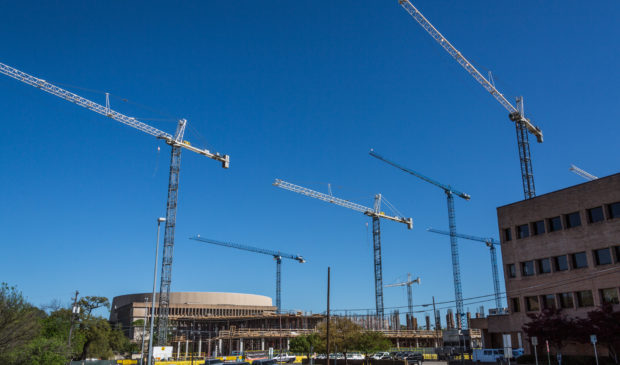Commission pushes for better mobility management around work zones
Friday, July 19, 2019 by
Ryan Thornton Despite the city’s plans for multimodal transportation infrastructure, proper bike lanes and fully accessible sidewalks are still a scarce public amenity in many parts of Austin. They are also often the first areas within the right of way to be impacted by delivery vehicles, service trucks, and most significantly, construction zones.
Acknowledging that some of those obstructions cannot entirely be avoided, the Downtown Commission is asking City Council to give direction to the Austin Transportation Department to explore regulations that could better protect the city’s active transportation facilities from the impacts of work zones.
Ryan Ward, manager of Austin Transportation’s Right of Way division, explained to the commission Wednesday that managing the right of way in construction areas has been particularly challenging in the downtown area. The division has only five inspectors to oversee the roughly 3,000 currently active construction permits throughout the city, and up until recently, only one inspector has been assigned to manage downtown Austin.
That single inspector was previously tasked with visiting construction sites to make sure the areas were free of any vehicles or equipment that would impact mobility during peak travel hours, before 10 a.m. and after 3 p.m.
The division has recently strengthened its downtown presence so that one day each week all five inspectors are checking work zones for right of way obstructions during peak hours. Those rigorous standards, however, only apply to projects that last fewer than seven days, while longer projects are managed separately.
By city rules, any work zone in place for longer than a week is subject to additional criteria for safety and is therefore allowed to leave its structures in place day and night, even when there is a clear impact on mobility. Those long-term projects are subject to a more thorough review process in which the division uses the city’s Transportation Criteria Manual, the Americans with Disabilities Act and the Texas Manual on Uniform Traffic Control Devices to determine whether the construction plan makes the necessary accommodations for impacting the right of way.
However, Commissioner Meghan Skornia told Ward the division is not doing enough to prioritize multimodal transportation. Referencing the work zone of a 32-story tower at 300 Colorado St. that redirects pedestrians through the northern section of the Lance Armstrong Bikeway, she said impacts to bike and pedestrian facilities should be a much stronger consideration when giving out construction permits.
“The bikes are pushed out into the street with no sign and then the construction entrance is right adjacent to the Lance Armstrong Bikeway, which is our only protected bike lane, east-west, downtown,” Skornia said.
For now, Ward said the division is limited to the regulations in the city’s Transportation Criteria Manual, a document that is currently being updated by the Transportation Department for unrelated reasons. Rather than prohibiting obstructions to sidewalks or bike lanes, the manual creates a set of conditions to meet when doing so.
“We can’t necessarily say ‘you can’t block this bike lane’ if they’ve created a detour that’s compliant and keeps pedestrians within a certain distance,” Ward said.
Although the city requires developers to provide an official detour for sidewalks that are closed due to construction work, bike lane closures only necessitate adequate signage indicating that cyclists should merge into the adjoining travel lane.
With long-term construction projects often lasting many months, Skornia made a motion Wednesday evening to push the city to increase requirements for bike lane closures. Those changes would include discouraging the placement of work zone entrances next to bike lanes and requiring developers to provide a detour for closed bike lanes that offers the same level of service as the closed facility.
“If you’re blocking a protected lane, it has to be protected where your detour is, etc.,” Skornia explained.
Ward expressed optimism that the direction may be coming at an auspicious moment, given the ongoing update to the Transportation Criteria Manual. In an email to the Monitor, however, Jacob Barrett, one of the department’s public information specialists, said the update may reference the impact of construction on sidewalks and bike lanes but “it will not be something that is directly addressed.”
Of course, Council will also have a say in the discussion when the commission’s recommendation comes up next.
Skornia’s motion passed unanimously with only minor amendments to the language added for clarity and practicality.
Photo by Counse made available through a Creative Commons license.
The Austin Monitor’s work is made possible by donations from the community. Though our reporting covers donors from time to time, we are careful to keep business and editorial efforts separate while maintaining transparency. A complete list of donors is available here, and our code of ethics is explained here.
You're a community leader
And we’re honored you look to us for serious, in-depth news. You know a strong community needs local and dedicated watchdog reporting. We’re here for you and that won’t change. Now will you take the powerful next step and support our nonprofit news organization?











